Habitat: Usually found in arid regions, fields, and wooded lands.
Length: Average 45 centimeters, maximum 90 centimeters.
Distribution: Australia, New Guinea, and Moluccas.
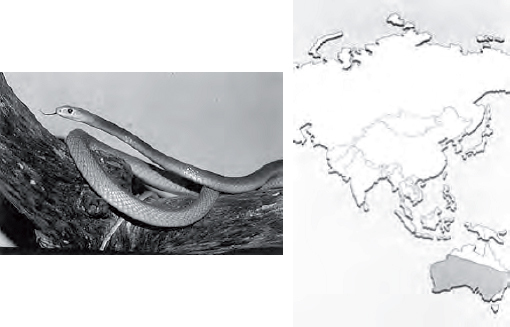
Taipan
Oxyuranus scutellatus
Description: Generally uniformly olive or dark brown, the head is somewhat darker brown.
Characteristics: Considered one of the most deadly snakes. It has an aggressive disposition. When aroused, it can display a fearsome appearance by flattening its head, raising it off the ground, waving it back and forth, and suddenly striking with such speed that the victim may receive several bites before it retreats. Its venom is a powerful neurotoxin, causing respiratory paralysis. Its victim has little chance for recovery without prompt medical aid.
Habitat: At home in a variety of habitats, it is found from the savanna forests to the inland plains.
Length: Average 1.8 meters, maximum 3.7 meters.
Distribution: Northern Australia and southern New Guinea.
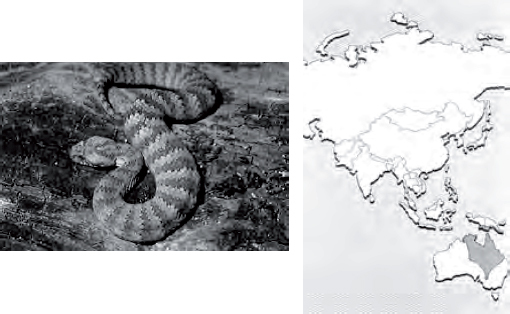
Tiger snake
Notechis scutatus
Description: Olive to dark brown above with yellowish or olive belly and crossbands The subspecies in Tasmania and Victoria is uniformly black.
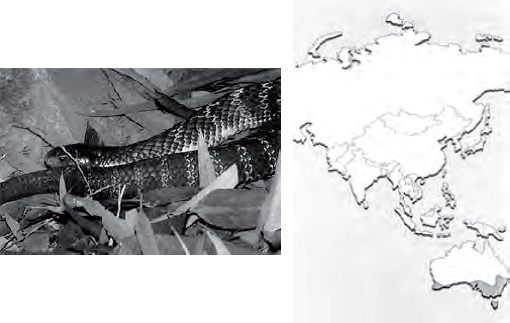
Characteristics: It is the most dangerous snake in Australia. It is very common and bites many humans. It has a very potent neurotoxic venom that attacks the nervous system. When aroused, it is aggressive and attacks any intruder. It flattens its neck making a narrow band.
Habitat: Found in many habitats from arid regions to human settlements along waterways to grasslands.
Length: Average 1.2 meters, maximum 1.8 meters.
Distribution: Australia, Tasmania, Bass Strait islands, and New Guinea.
POISONOUS SEA SNAKES
Banded sea snake

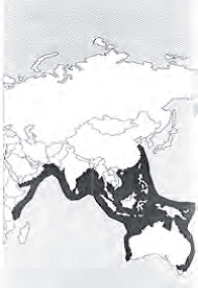
Laticauda colubrina
Description: Smooth-scaled snake that is a pale shade of blue with black bands. Its oarlike tail provides propulsion in swimming.
Characteristics: Most active at night, swimming close to shore and at times entering tide pools. Its venom is a very strong neurotoxin. Its victims are usually fishermen who untangle these deadly snakes from large fish nets.
Habitat: Common in all oceans, absent in the Atlantic Ocean.
Length: Average 75 centimeters, maximum 1.2 meters.
Distribution: Coastal waters of New Guinea, Pacific islands, the Philippines, Southeast Asia, Sri Lanka, and Japan.
Yellow-bellied sea snake
Pelamis platurus
Description: Upper part of body is black or dark brown and lower part is bright yellow.
Characteristics: A highly venomous snake belonging to the cobra family. This snake is truly of the pelagic species—it never leaves the water to come to shore. It has an oarlike tail to aid its swimming. This species is quick to defend itself. Sea snakes do not really strike, but deliberately turn and bite if molested. A small amount of their neurotoxic venom can cause death.

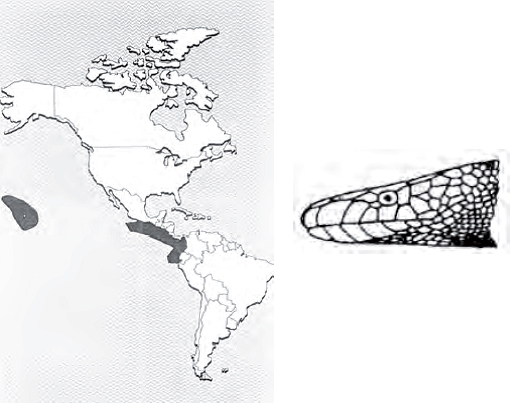
Habitat: Found in all oceans except the Atlantic Ocean.
Length: Average 0.7 meter, maximum 1.1 meters.
Distribution: Throughout the Pacific Ocean from many of the Pacific islands to Hawaii and to the coast of Costa Rica and Panama.
POISONOUS LIZARDS
Gila monster
Heloderma suspectum
Description: Robust, with a large head and a heavy tail. Its body is covered with beadlike scales. It is capable of storing fat against lean times when food is scarce. Its color is striking in rich blacks laced with yellow or pinkish scales.
Characteristics: Not an aggressive lizard, but it is ready to defend itself when provoked. If approached too closely, it will turn toward the intruder with its mouth open. If it bites, it hangs on tenaciously and must be pried off. Its venom glands and grooved teeth are on its bottom jaw.
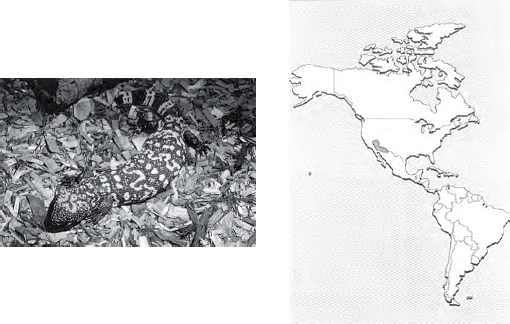
Habitat: Found in arid areas, coming out at night or early morning hours in search of small rodents and bird eggs. During the heat of the day it stays under brush or rocks.
Length: Average 30 centimeters, maximum 50 centimeters.
Distribution: Arizona, New Mexico, Utah, Nevada, northern Mexico, and extreme corner of southeast California.
Mexican beaded lizard
Heloderma horridum
Description: Less colorful than its cousin, the gila monster. It has black or pale yellow bands or is entirely black.
Characteristics: Very strong legs let this lizard crawl over rocks and dig burrows. It is short-tempered. It will turn and open its mouth in a threatening manner when molested. Its venom is hemotoxic and potentially dangerous to man.
Habitat: Found in arid or desert areas, often in rocky hillsides, coming out during evening and early morning hours.
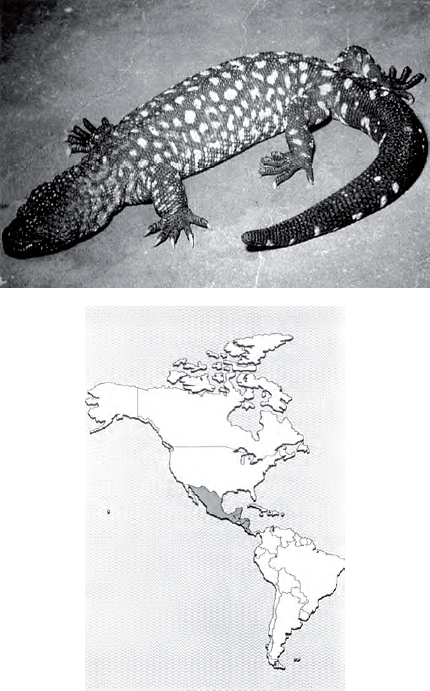
Length: Average 60 centimeters, maximum 90 centimeters.
Distribution: Mexico through Central America.
CHAPTER 5
DANGEROUS FISH, MOLLUSKS, AND FRESHWATER ANIMALS
Since fish and mollusks may be one of your major sources of food, it is wise to know which ones are dangerous to you should you catch them. Know which ones are dangerous, what the dangers of the various fish are, what precautions to take, and what to do if you are injured by one of these fish.
Fish and mollusks will present a danger in one of three ways: by attacking and biting you, by injecting toxic venom into you through its venomous spines or tentacles, and through eating fish or mollusks whose flesh is toxic.
The danger of actually encountering one of these dangerous fish is relatively small, but it is still significant. Any one of these fish can kill you. Avoid them if at all possible.
DANGERS IN RIVERS
Common sense will tell you to avoid confrontations with hippopotami, alligators, crocodiles, and other large river creatures. There are, however, a few smaller river creatures with which you should be cautious.
Electric Eel
Electric eels (Electrophorus electricus) may reach 2 meters in length and 20 centimeters in diameter. Avoid them. They are capable of generating up to 500 volts of electricity in certain organs in their body. They use this shock to stun prey and enemies. Normally, you find these eels in the Orinoco and Amazon River systems in South America. They seem to prefer shallow waters that are more highly oxygenated and provide more food. They are bulkier than our native eels. Their upper body is dark gray or black, with a lighter-colored underbelly.
Piranha
Piranhas (Serrasalmo species) are another hazard of the Orinoco and Amazon River systems, as well as the Paraguay River Basin, where they are native. These fish vary greatly in size and coloration, but usually have a combination of orange undersides and dark tops. They have white, razor-sharp teeth that are clearly visible. They may be as long as 50 centimeters. Use great care when crossing waters where they live. Blood attracts them. They are most dangerous in shallow waters during the dry season.